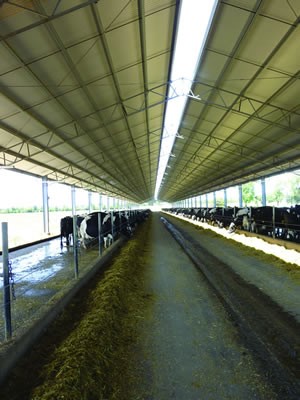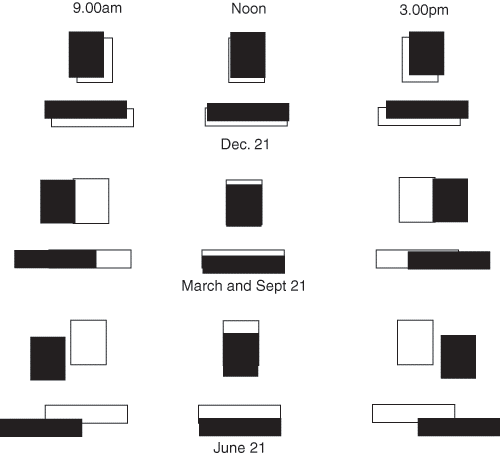Feedpad Shade Structures
Permanent shade structures over feedpads can reduce the impact of heat stress on overall farm productivity.
Permanent shade sheds are an investment that provide excellent protection from solar radiation, but they must be well designed and constructed. A well considered orientation for the site will shift the shaded area across the pads during the day. This spreads manure deposits over a larger area as the cows move with the shade.
An effectively designed and built shade shed provides:
- sufficient room for resting and standing
- comfortable, hygienic lying surfaces
- clean, dry surfaces for standing and feed placement
- a safe environment to minimise injury
- smooth, quiet stock movement.
Note that the orientation and roof design of the shade structure will influence the amount of solar radiation that it can block.
Strengths
- Have a long useful life, at least 25 years.
- Doubles as a feedout facility,
- Can be used to protect pastures and prevent soil pugging during prolonged periods of rainfall.
- Can be used to break the growth cycle of parasites such as cattle tick and reduce the need for chemicals.
- Can be fitted with evaporative cooling systems such as sprinklers and fans.
- Can be converted into a freestall or integrated with loafing pads if well designed.
Limitations
- Location on farm is not always ideal for paddock rotation.
- High capital cost to provide shade. Cost depends on amount of concrete; type of roof, strength of structure required to support roof and the effluent management system.
- Must have an effective system for handling effluent and run-off, otherwise cow comfort and production may be compromised.
- Need to comply with regulatory authorities (e.g. local council building permit for solids roof structures.

Keys to success
- Shade structures close to the dairy will make management easier, as staff can monitor the herd while preparing for milking or post-milking clean-up.
- Consider prevailing winds, radiation from the sun and rainfall. Structures need to be able to withstand extreme weather conditions.
- Daily scraping of earthen feedpad surfaces helps manage the risk of mastitis.
- An effective effluent system for handling effluent and run-off.

Solid-roof shade structure design
|
Element |
Recommendations |
|
Roofing material |
Roof material may be aluminium or white galvanised iron sheets to increase the rate of solar reflection. This should last at least 25 years. |
|
Roof height |
For good machinery access, the roof height should be at least 3.7 metres |
|
Roof pitch |
Lower roof pitch results in slower air movement (e.g. 1:4 pitch or less). Steeper roof pitch results in greater air movement (e.g. 1:3 pitch is suggested for warmer climates). Provide a continuous open ridge to promote air movement (i.e. convective heat dissipation via the stack effect). Recommendations for open ridge space: 50-75 mm/3.0 m of shed width (DPC et al 2009). 300 mm + 50 mm per 3 m width for sheds greater than 6 m wide for northern Australia |
|
Eave overhang |
The recommended overhang for open-sided sheds is 900 mm. Eave overhang is dependent on feedpad/ freestall configuration, and on eave height and degree of protection required. |
|
Orientation |
East-west or North-south |
|
Gutter and downpipe design |
As per state plumbing code (engage a qualified design engineer). The Roof and Gutter Design Calculator has both free and paid resource for the design and construction of guttering and roof design. |
Roof pitch
Lower roof pitch results in slower air movement (e.g. 1:4 pitch or less). Steeper roof pitch results in greater air movement (e.g. 1:3 pitch is suggested for warmer climates).
Enclosing a shelter using sheeting, a blind or even a furled shade cloth can contribute to significant horizontal wind loads which could cause structural failure. If the angle of inclination of a roof or shade cloth is 15° or so, it will generate lift. Like an aircraft wing.
Minimise lift by either flattening the inclination of the roof to between 10 and 14° or installing it with an inclination in excess of 20°. Roof angles of 15 to 18° should be avoided.

Orientation
With an east-west orientation, and an area of 2.5 to 3 m2/cow, part of the floor area under the roof will be in shade all day. Extending the floor about one third its length on both the east and west to 3 to 4 m2/cow will place feed and water troughs under shade at all times, which will encourage intakes. More dung will be dropped in the shaded area, which will need frequent cleaning to avoid the risk of mastitis.
East-west orientation, therefore, works best for concrete floors. If concrete is too costly, the north-south orientation works best.
It works well for a compacted clay or gravel floor because the sun strikes every part of the floor area under and on either side of the roof at some time during the day. This helps to keep the floored area dry and restricts pathogen build up.
A shaded area of 2.5 to 3 m2/cow is adequate if feed and water troughs are placed away from the shaded area. In regions where temperatures average 30°C or more for up to 5 hours/ day during some period of the year, the east-west orientation is deemed more suitable.

Shed profiles at 9 am, noon and 3 pm at four different times of the year.
Effluent management systems
An effective system for handling effluent and run-off is essential, otherwise cow comfort, health and production may be compromised. Refer to section 8.0 of Guidelines for Victorian Dairy Feedpads and Freestalls (DPIV 2009).
For a more in-depth discussion on the sustainability aspects of Dairy Effluent Management, visit the Dairying for Tomorrow website.
-
Reference material and resources for each state/territory
Regulatory body
Resource
Federal Department of Agriculture and Water Resources
Agriculture Victoria
Water NSW
Tasmanian Department of Primary Industries, Parks water & Environment
Queensland Department of Agriculture and Fisheries
SA Environmental Protection Agency
WA Department of Water and Environment Regulation
If you are deaf, or have a hearing impairment or speech impairment, contact the above resources through the National Relay Service on 133 677 or visit www.relayservice.gov.au
-
Regulatory and Building Authorities for each state/territory
Solid roof structures need to comply with regulatory authorities, e.g. a local council building permit is required.
State
Resource
Victoria
Victorian Building Authority (VBA) has recently announced new categorisation and regulations for shade structures in Victoria.
Regulations on Farm Structures
VBA Regulations (new farm structure changes)
Plumbing in Victoria
New South Wales
The NSW Planning Portal provides all advice and guidance on shade structures.
Regulations for Farm Structures
Plumbing in New South Wales
Queensland
QLD Department of Housing & Public Works (HPW)
HPW is a central resource for plumbing and construction in this state.Regulations for Farm Structures
Plumbing in Queensland
Tasmania
Tasmania's Consumer, Building and Occupational Services (CBOS)
Regulations for Farm Structures
Plumbing
South Australia
SA's EPA is the regulatory body for farming structures
Regulations
Western Australia
The Department of Primary Industries and Regional Development is responsible for regulation shade structure constructions in WA.
Regulations
A guide for construction & developments on land holdings in Western Australia
If you are deaf, or have a hearing impairment or speech impairment, contact the above resources through the National Relay Service on 133 677 or visit www.relayservice.gov.au



